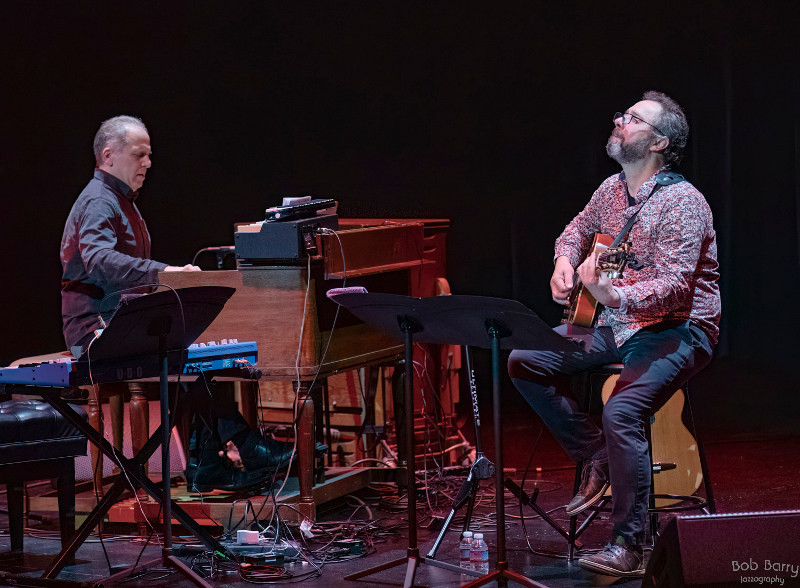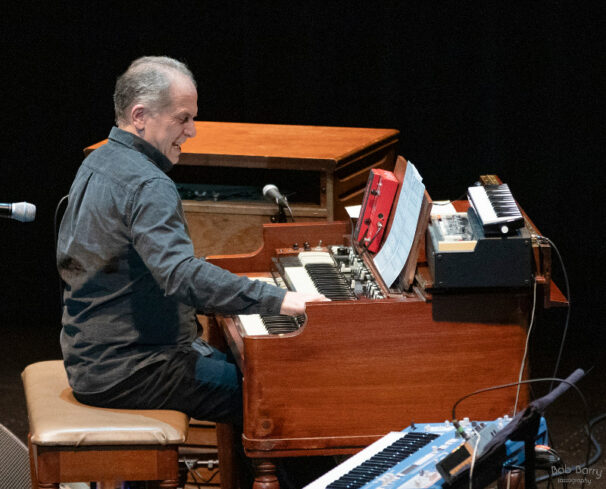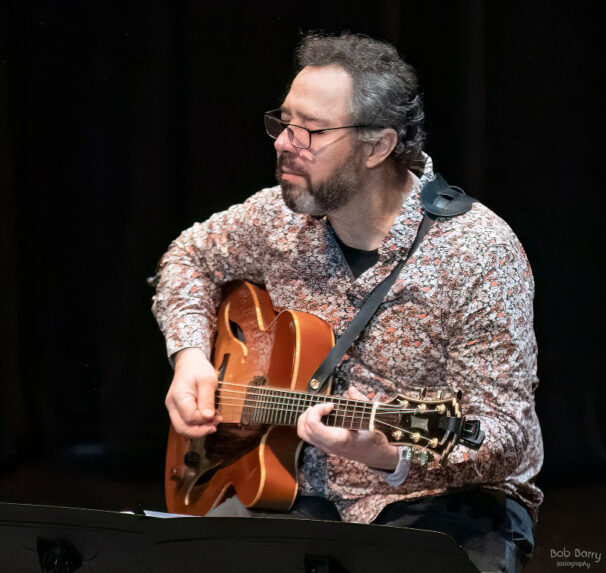
It’s a quiet Saturday night on Westwood Boulevard, and all that’s left of the latest rainstorm is a light mist. The Nimoy Theater marquee is the brightest thing on the street, and it draws some people inside. Organist Larry Goldings and guitarist Larry Koonse are playing jazz duets tonight, under the aegis of Ruth Price. The Jazz Bakery’s “moveable feast” is presenting the duo.
The comfortable theater, formerly The Crest, is a little over half full. The acoustics are good, as are the sightlines. Neither Goldings nor Koonse top any magazine polls or record under their own names for major labels. They’re musicians’ musicians. Still, the likes of film critic Leonard Maltin, Cal Arts Jazz Program Director David Roitstein, Yellowjackets saxophonist Bob Mintzer, and singer and vocal jazz maven Cathy Segal-Garcia are among those who have braved the cold temperatures to hear the music.
The Two Larrys, as they refer to themselves with jocular self-effacement, take the stage like postal carriers closing in on a mail room. They’re not stars (though Goldings was a recent mid-tour substitute for Steely Dan—a trial-by-fire experience that he crushed), and effusive introductions are not their style. They prefer to let the music speak.


Goldings and Koonse share a reputation for enhancing any music setting. They play with temperate volume, listen intently to each other, value space, and react in real time to what’s being played. Though the organist and guitarist have a lot to say at any given juncture, attentive listeners know that they never show all of their musical cards–an admirable quality. Goldings and Koonse dole out adult portions of the three major musical food groups—melody, harmony and rhythm—for two delicious hours.
Koonse plays an electric hollow-body Gibson BG 112. On the medium tempo opening number–as the two players ping-pong their statements and exchange solo and accompanist roles—his staccato phrases are warm rather than brittle. Koonse always plays with poise, choosing his notes and chord carefully, yet looking down the road a couple of bars to see what’s coming.
Koonse tips his hat, on his own “Light and Shadow,” to the late jazz guitar icon Jimmy Wyble (1922-2010). (Wyble was a Cajun from Louisiana, played in Western swing bands, and loved Bartok. Like Goldings and Koonse, a musicians’ musician.) As Goldings plays sleek chords underneath, Koonse plucks obliquely around a melody. They seamlessly hand off solo and background roles, calibrating their dynamics downward, going from quiet plucking on the low end to a swelling organ crescendo on the top.
An unannounced tune with other-worldly organ sounds seems to proceed on the wrong rhythmic foot; it sounds like it’s in three but that the two is the strong beat. A chase sequence takes the tune into higher harmonic mathematics. A spray of linear organ notes from Goldings’ right hand draws a grin from the attentive Koonse, and he strums chords in time.
On “It Ain’t Necessarily So,” shimmering organ chords that conjure a wave spreading up onto shore, before they settle into the blues. With the swaggering jaunt of the tempo, it’s hard to say who is having a better time. Goldings gives a mini history of the electric organ in jazz, from Jimmy Smith forward.
Goldings moves to a UDO Super 6 electronic keyboard. Some repeated figures begin to loop, thanks to an added sequencer. The guitar responds pointedly, before Goldings jumps back onto the organ. Quite the aural odyssey, albeit a short one.
A sprightly little waltz rolls forward, before an out-of-tempo solo stretch seems to stop time for a couple of minutes. Goldings and Koonse are soaring around in the strata of higher structural triads, and there are more than a few open mouths in the audience. Koonse’s crystalline opening illuminates Michel Legrand’s “You Must Believe in Spring” precede neon organ washes on a retooled Lennon & McCartney’s “Here There and Everywhere.”
“This will make you feel like you’re in a 1960s lounge,” Goldings says to introduce his own funky “Crawdaddy.” Sure enough, the globular organ chords conjure bubbling mental lava lamps, and a lighted aquarium behind a bar. It’s a cold winter night, but it’s toasty inside the Nimoy .
photo credit: bob barry
Kirk Silsbee publishes promiscuously on jazz and culture.
